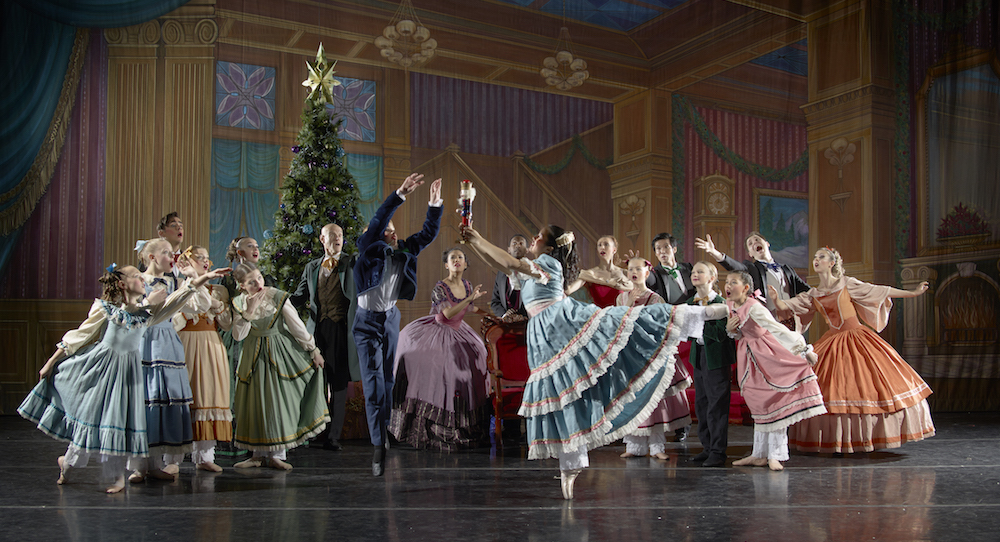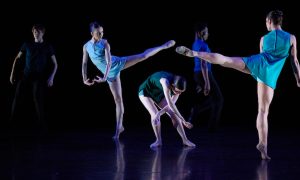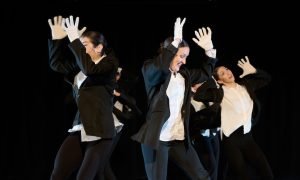The Cutler Majestic Theatre, Boston, Massachusetts.
December 1, 2017.
By and large, we live in a culture with an overarching message of “more is better” – bigger, faster, brighter, louder. Some Nutcracker presentations go right along with this ethos (granted, with pleasing harmony of aesthetic elements) – big leaps, a booming score, ornate costumes, dazzling technical effects. Some productions focus more on sweet moments amongst characters, grace over flash, and offering of realistic (versus ostentatious) design elements. José Mateo Ballet Theatre’s The Nutcracker this season did just this.
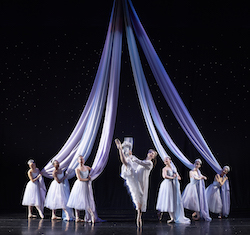
José Mateo Ballet Theatre’s ‘The Nutcracker’. Photo by Gary Sloan.
The result was easy smiles and laughter for all, and walking away filled with the true spirit of the season. Big technical tricks, flashy costumes and blindingly-bright lights might have just drowned out the authentic joy and magic at the root of the production, and in the holiday season overall. This take began with the opening of large, long white sheets draped from the ceiling (scenic design by Laura McPherson).
Dancers in white moved with them and created different shapes. The backdrop sparkled. It all built a gorgeous (yet not over-the-top) white/silver color scheme and aesthetic. Clara (Amy Chan) entered, offering an easy, joyful lightness. At one moment, dancers concealed under the sheets peeked out – a sweet moment bringing a small laugh.
Then to Drosselmeyer’s toy shop, a scene not always included in Nutcracker productions. Harlequin (Junichi Fukuda) and Columbine (Magdelena Gyftopolous) danced solos and a pas de deux, with soft yet precise execution. The color scheme here was fiery, with yellows and reds, in scenery and costumes (costume design, and choreography, by José Mateo).
The scene closed with a moment both touching and unique – Harlequin pushed Columbine’s box offstage while in relevé attitude. This sense of movement segued nicely into the party scene, in a wonderfully decorated (but not ostentatiously so) grand ballroom. Women wore big hoop skirts that felt historically authentic rather than meant for a “wow” effect (although it did offer that as well!).
Drosselmeyer (Jim Banta) entered, and all froze! He mimed and all watched, clearly with a mysterious power to control the space and all those in it. With his presence, Harlequin and Columbine made their re-appearances, with power and panache. They ate up stage space in intricate turns and leaps, yet kept the essential movement characteristics of their characters (Columbia’s doll double-bounce, the angularity of Harlequin).
Drosselmeyer had that ominous mysteriousness, yet the mice were humorous and cute. A few times, they lay on their back and kicked with legs up to the sky. The audience giggled in simple, pure delight. The soldiers moved in crisp lines, stepping and turning with swords extended or swooping. Clara killed the Rat King (Jean Robens Georges) with a sword, rather than a shoe, as is traditional. This change empowered her as a young girl still with the strength to bear a sword.
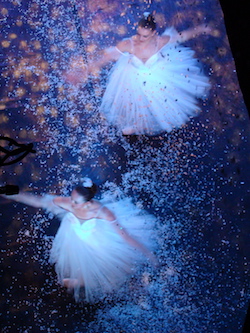
José Mateo Ballet Theatre’s ‘The Nutcracker’. Photo by Gary Sloan.
The threat gone, the tree behind them grew, yet not so much that it couldn’t still be a real tree. This added to the warm realism of the whole performance. The lovely Snow Scene then emerged, the graceful Snowflakes moving in circles and lines across the stage space. Four danseurs allowed for partnering, which added to a three-dimensional picture of the stage space. There was sometimes sloping inward toward, sometimes outward away from, center stage.
Even when the music picked up speed, the Snowflakes didn’t miss a beat, and demonstrated just as much ease. There were unique and compelling signatures to the movement as well, such as light wrist flick with the arms in “V” or fifth position en haut. This was a simple touch but added something to make these characters more than just blank objects that move. Snow Queen (Angie DeWolf) led them all – with grace, yet also courage and daring. She let the movement be what is was, yet with stable strength beneath it.
The Angels opened the second act, a thread from the opening (with the same music and costuming). Despite this connective thread, these Angels aren’t in all Nutcracker productions. They walked, with true poise, candles in hand – a simple yet powerful symbol of light, warmth, and joy. The Sugar Plum Fairy (Madeliene Bonn) and her Cavalier (Stephen James) lifted the whole scene through their graceful carriage.
Sugar Plum’s attendants executed phrasework anchored in attitude chassé, smiles wide and control impressive. The Flowers waltzed to help build the elegant, picturesque scene. Then to the many divertissements of The Kingdom of the Sweets. The sequencing of the Chocolate/Spanish duet (Patricia Chiang and Jean Robens Georges) – two simultaneous solos, then unison work – felt like an authentic interaction between two people.
Coffee/Arabian (Angie DeWolf and Spencer Doru Keith) was just as much about strength as it was about flexibility. The variation is often centered on feats of flexibility to the point of contortion, so this was a refreshing change of quality. It didn’t need tricks to make an impact. Also interesting was the air of female empowerment, such as with DeWolf exiting last. This is quite a contrast to the danseur’s clap for the ballerina in many Nutcrackers.
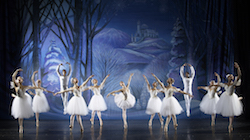
José Mateo Ballet Theatre’s ‘The Nutcracker’. Photo by Gary Sloan.
Chinese Tea (Jaclyn Sanford and Kanna Kitsunai) was smooth and on point with timing. The movement was precise, but the overall variation offered carriage and showmanship more than technical feats. There were flexed palms, aesthetically harmonious with the overall choreography, rather than “chopstick” fingers. This choice made clear that there are ways to update this show, to avoid cultural insensitivity and still maintain the magic.
One ballerina and one danseur danced Trepak/Russian (Lauren Ganther and Junichi Fukuda), offering both a sense of lift and that of groundedness. Just as with Tea, there were technical challenges, yet more meaningful was that up-down balance. Momentum was key, driving the dancers’ power.
Marzipan/French (Brittany Bush with Betsy Boxberger and Cecilia Zevallos) followed, a ballerina trio in soothing lavender tutus. This variation is pure classical technique, and they offered it with polish; there are just about no contemporary movements or character flourishes to hide behind! The ending was picturesque, two dancers kneeling and one on relevé.
Next came the Polichinelles, children executing elementary but pleasing movement and demonstrating pure professionalism. Mother Ginger was the visual center with her enormous skirt. Some Nutcrackers include Drosselmeyer and Clara, but the stage picture here was more than enough to enjoy without them. The Flowers followed, in bright skirts and tutus of all different colors – just like how a garden has flowers of all different colors and shapes.
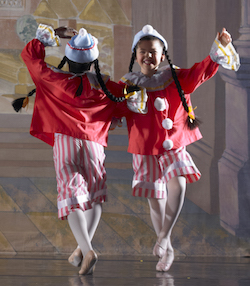
Polichinelles in José Mateo Ballet Theatre’s ‘The Nutcracker’. Photo by Gary Sloan.
Dewdrop (Haruka Tamura), however, was in a simple, yet very elegant white Empire dress with a pink ribbon at the bodice – the lovely white lily of the group. Her endless line and fearless attack were hard to draw one’s eyes away from. Also pleasing was the staging and formations – continuous shifts of formation, cannon, and other choreographic tools to keep it all moving. It was all like a gentle breeze shifting a group of flowers all about.
Emblematic of the overall show, the main qualities of the Grand Pas were lovely carriage, ballon and smooth lifts, rather than endless wow-worthy tricks. There were those, too, however; Bonn’s extensions floated for days, James’s turns were strong, and their ending shoulder sit brought immediate applause. The Finale offered both group and individual opportunities for many characters to shine.
The final end was a hug of Clara and Drosselmeyer, and a wave to the Snow King and Queen. There was a sense of continued friendships. With that, let us remember what really matters this holiday season: the company of loved ones can be more than enough, minus all the glitz, glam and hubbub. Brava to José Mateo Ballet Theatre for making this truth clear, letting elegance, grace and aesthetic harmony shine in an age of idolizing “more”.
By Kathryn Boland of Dance Informa.


